Historical Misfits: The Flying Jeeps
In my first article of historical misfits I went over the flying saucer VZ-9 Avrocar “The Flying Jeep”. In this article I will be going over the other candidates that the U.S. military had in the running. It appears that they really, really wanted a flying jeep. Something that a common soldier could operate, but would also be able to fly over any obstacles on the battlefield quickly.
Hiller Flying Jeep
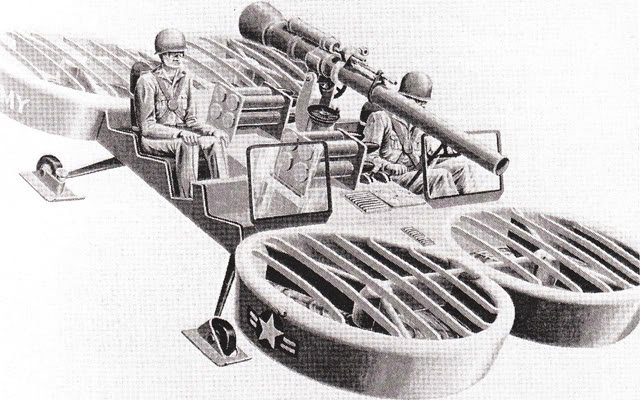
If you remember from my article on flying platforms, the Hiller company had the best model of the 1950/60's. This was the continuation of their platforms, adding one at each corner to create a flying jeep! Based off the success of their platform models, and the fact that they were the leading company with fan ducted aircraft I am sure this would have been a success.
Unfortunately due to military contracting requirements, they had to source bids from other contractors. Awarding funding to the other companies I list below. Hiller said they should have made a 'mock-up' with their own money to show the generals, because if they could see it and sit in it they would have wanted it. They never got a chance to create this, so all we have are the drawings.
Shame.
Chrysler VZ-6
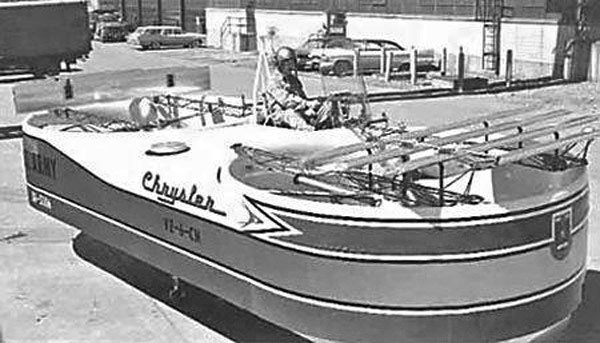
Two prototypes of this design were made for military testing purposes in 1958. It looks like a boat to me, and in some ways was an early hovercraft. It featured two downward thrusting propellers powered by a single 500hp engine and thick rubber skirts to keep the air beneath it. To get this boat moving the pilot would tilt the craft slightly forward and focus some of the air through rear facing ducts. This was never meant to fly very high, just around 5 or 6 feet.
All this equipment and the size of the thing meant it weighed 2,400lbs and with just the one 500hp engine meant that is was way too underpowered. Not only that, during a test flight this thing managed to flip completely over and wreck itself. Luckily the pilot was not killed. In 1960 the remaining prototype was scrapped as well.
General characteristics:
Crew: 1
Length: 21ft 6in (6.55m)
Height: 5ft 2in (1.57m)
Gross weight: 2,400lbs (1,089kg)
Powerplant: Lycoming , 500hp
Main rotor diameters: 8 ft 6 in (2.59m)
Get outta here with this crap Chrysler! Next.
Curtiss-Wright VZ-7
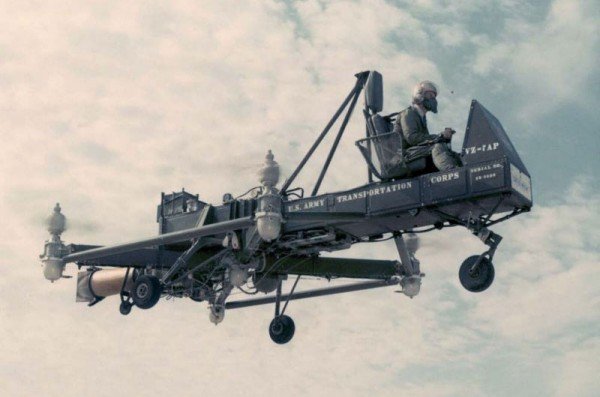
This looks like something the drone designers of today copied. Two prototypes were delivered to the army in 1958. The 430hp engine was located just behind the pilot, four propeller blades were attached to each corner. While it looks rather basic, it was reported to have been very easy to fly, maybe another reason civilian drones look so much like it.
Even though it was a breeze to fly, it was rather slow with a maximum speed and height of only 32mph and 200ft respectively. Which would have been a pretty easy target for any enemy to follow. Both prototypes were returned to the manufacturer in 1960. One is in storage at the United States Army Aviation Museum in Fort Rucker, Alabama. Maybe you can convince someone to let you take a look at it.
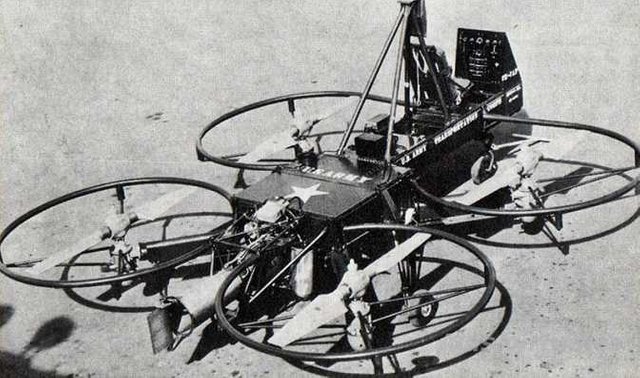
General characteristics:
Crew: One pilot
Length: 17ft (5.18m)
Width:16ft (4.87m)
Height: 9ft 3in (2.83m)
Powerplant: Turbomeca Artouste IIB turboshaft, 430hp
Maximum speed: 32mph (51km)
Service ceiling: 200ft (60m)
Piasecki VZ-8 Airgeep
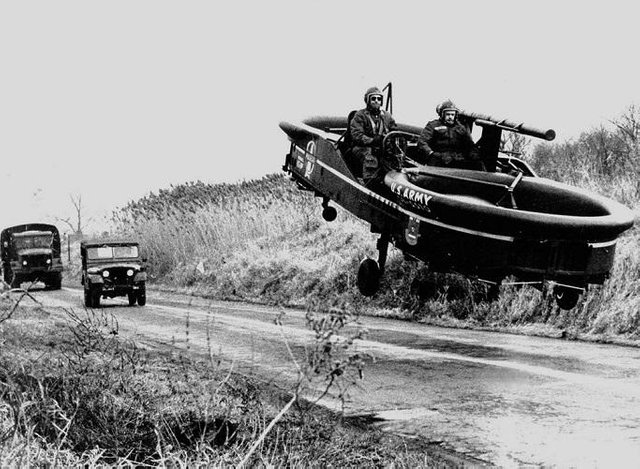
This designed appeared to have the most promise, as it lasted longer and had more modifications than all the others. The initial prototypes were first flown on the 22nd of September, 1958. These first Airgeeps had a crew of two and the two rotors were powered by a 425hp engine.
One modification to increase the carry capacity featured two 400hp engines and could carry five people. This one was called the PA-59H.
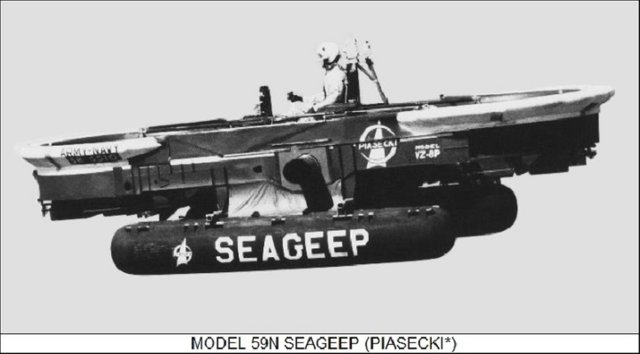
After many successful flights, with even a model made for the navy that had water floats dubbed the Seageep, the engine was replaced with a lighter but more powerful 550hp one. This was designated the Airgeep II and had its first test flight on the 15th of February 1962.
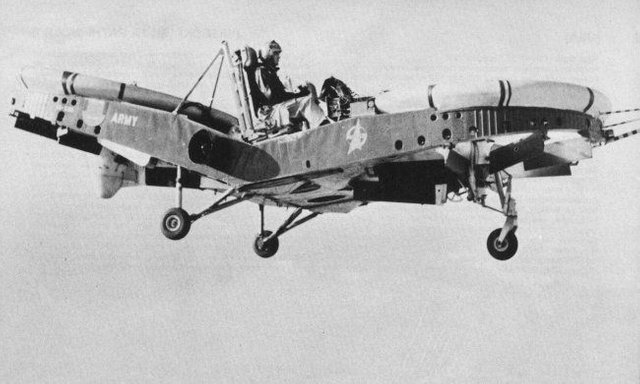
These prototypes were made to operate low to the ground but were actually able to go as high as 3,000ft and had a maximum speed of 85mph and still have stable flight. You might be saying like I did, “Why don’t we have these then?” Well, the army in all its wisdom stated “The flying jeep concept is unsuitable for the modern battlefield.” And focused their research to normal helicopters.
I say if they could do this in the 1960's, someone should be able to build up one of these baby's in their garage! Anyone reading this got some skills? Could put the steemit logo on the side, fly it around town. That would get some attention.
General characteristics:
Crew: 2 (Pilot and co-pilot/gunner)
Capacity: up to three passengers on the model PA-59H only.
Length: 24ft 5in (7.45m)
Width: 9ft 3in (2.82m)
Height: 5ft 10in (1.78m)
Empty weight: 2,611lb (1,184kg)
Gross weight: 3,670lb (1,665kg)
Max takeoff weight: 4,800lb (2,177kg)
Powerplants: 2 × Turbomeca Artouste IIC turbo-shaft engines, 550hp each
Main rotor diameters: 8ft 2in (2.5m)
Maximum speed: 85mph (136km)
Cruise speed: 70mph (112km/h)
Range: 35mi (56km)
Service ceiling: 2,999ft (914m)
Guns: Provision for one - not fitted
Like this? Check out these articles:
Historical Misfits: Flying Platforms
Historical Misfit: VZ-9 Avrocar
Sources
- Strange Vehicles: Curtiss-Wright VZ-7
- Strange Vehicles: Chrysler VZ-6 Flying Jeep
- The Flying Platforms & Jeeps
- Hiller Flying Jeep
Photos not referenced were sourced from the above links.
Never before heard of these things. Crazy looking!
Yeah, a very interesting group of prototypes from 55 years ago! If you like these ones, you should check out this set of crazy single person flying devices!
Oh my word. Those single person flyers look inherently unstable! I admire their creativity and tenacity, but crazy!
I think the problem with a lot of those prototypes in addition to what you stated is the fact that they make A LOT of noise. It's hard to have a super secret mission in enemy territory when they can hear you from miles away.
Everything can have a time and place to be used. Plus these were prototypes, noise reduction wasn't on the list of priorities yet. But yeah, they were loud! :)
Where's the avengers' transportation? :-)
Heck, I've found a few things that could be the father to some of that stuff. Stay tuned. :)
👀 on you.:-)
There are some stability problems for these things - any VTOL, in fact, with its lifting means located low on the airframe - when operated near the ground. Enough to be a challenge even to modern controls. Main problem in those days would have been training GIs to operate them safely. That contradicted the main point of a flying jeep - namely NOT having to give specialized training. With helicopters, you definitely need specially trained pilots, but you also end up with much more efficient lifting systems.
Very good points here, thanks for the great comment :)
Unfortunately not me :)
Ok, I'll mark you off the list :-D
Cool stuff. Sure points to the politics in the US military industrial complex, even back then, doesn't it?
Sure does. Firmly entrenched for many decades!
Wow, @getonthetrain. If not for your article, I would never have believed these vehicles actually existed. Crazy stuff!
Pretty cool things they came up with back in the day! :)
excellent post I had no idea I learned something new today didactico thank you very much for the information
You're welcome jlufer